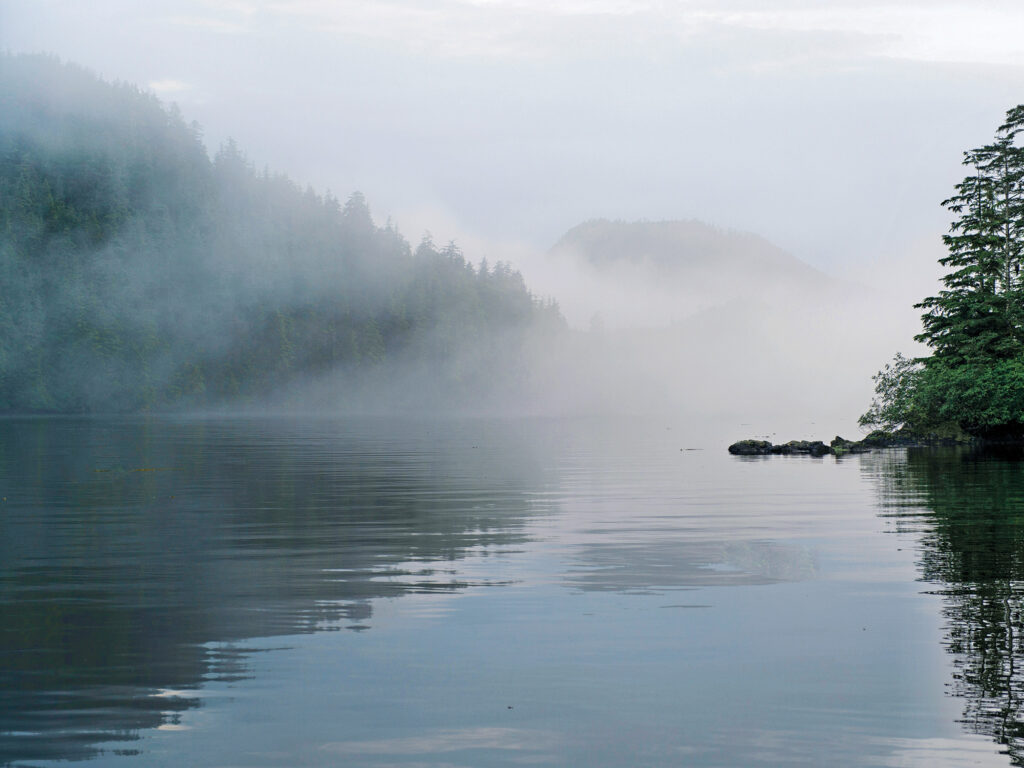
So it commenced, an unexpectedly magical trip with a couple of awesome shipmates, a journey that, in retrospect I wasn’t quite prepared for but will cherish forever. Aboard the rock-solid, sweet-sailing Cal 40 Dancing Bear, we set off from Anacortes, Washington, in mid-June, northbound for a group of islands off the coast of British Columbia called Haida Gwaii. It’s a remote archipelago about which I knew virtually nothing at the outset, but which is now forever embedded in my being.
My leg of the journey spanned several hundred miles, winding through the nooks and crannies, currents and majesty that is the Pacific Northwest. It involved a dear old sailing pal and a brand-new one. Looking back, it unfolded in a series of chapters, of self-contained vignettes. And it all started with…
I: Whiskey Night
An hour north of Seattle, in the woodsy sticks where my friend Mark Schrader’s barn and shop serves as headquarters for his construction and fabrication business, I’d arrived just in time for Friday evening’s Whiskey Night, an open-air gathering of like-minded characters who show up to chat and sip. It started during the pandemic days and took on a life of its own. Our voyage was conceived under these notably hazy circumstances.
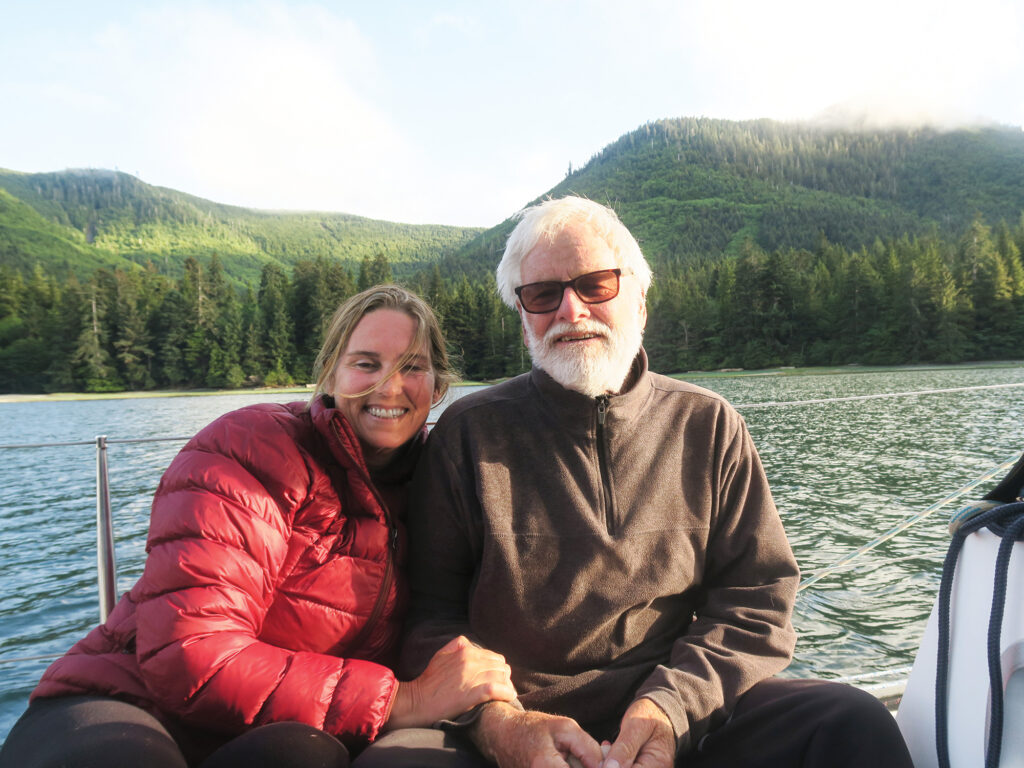
Mark and I went back a way. We’d first met in the mid-1980s, when he sailed in the second running of the BOC Challenge solo round-the-world race. Later, when he became the event’s race director, I worked for him in the media office. That led to some actual sailing, first aboard his tricked-out Dancing Bear for the 2005 Transpac race from Los Angeles to Honolulu. Then, in 2009-10, I was part of his core crew when he skippered the 64-foot steel cutter Ocean Watch on the Around the Americas expedition, a 28,000-nautical-mile spin around North and South America via the Northwest Passage and Cape Horn to raise awareness of ocean-health issues.
We’d put a lot of shared miles astern. However, Jenn and Mark Dalton were new friends. Jenn was a Canadian adventurer and kayaker who was a fledgling sailor, and who had just purchased a J/28. Many years ago, Jenn worked at a fishing resort on the island of Langara on Haida Gwaii’s northern flank. On a previous Whiskey Night, someone had unspooled the big pull-down map and plonked a finger there, and the first inkling of an impending plan was hatched. With Jenn’s experience in the islands, Mark reckoned she would make a great crewmate and extended an invitation.
Mark Schrader, Jenn and I would constitute the crew for the journey’s first half, from Anacortes up inside Vancouver Island to Haida Gwaii’s Daajing Giids. From there, Jenn’s husband, Mark Dalton, and I would swap positions. He’d continue northward to Langara and back to Anacortes on an offshore Pacific Ocean leg, leaving Vancouver Island to port.
My own contribution to Whiskey Night was to recount various embarrassing sailing moments with my friend Mark. I had loads of material and was more than happy to comply. Then, once the last caps on the bottles were spun back on, it was time to go sailing.
II: Oh, Canada!
After a midday start from Anacortes, the opening 30-nautical-mile stretch of our trip basically involved winding our way through the pristine San Juan islands and into Canadian water. As we motorsailed along the northern shore of Orcas Island, I looked up to see a quartet of eagles lazily wheeling overhead in the thermals. Not for the last time, it struck me that I was no longer back home in Rhode Island.
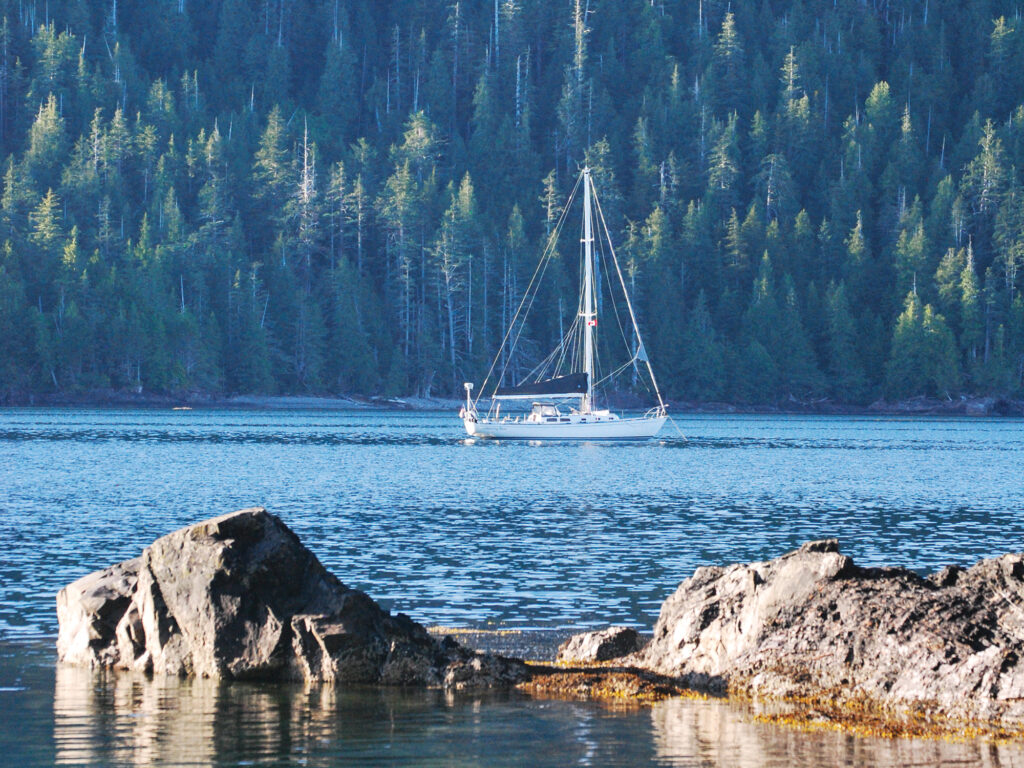
We closed in on the well-named Boundary Pass, which serves as the invisible at-sea border of the United States and Canada, and I saw a “big rip currents” note on the chart plotter. I wondered if they had anything to do with the confluence of waters separating mellow Canada from crazy America. Either way, the whirlpools were evident, and the aqua was seriously moving. One instant, with a favorable nudge, we’d zip along at 9 knots. Five minutes later, laboring into it, we’d be hard-pressed to make 5. Go with the flow, indeed.
As we closed in on our first Canadian port of call at Bedwell Harbour on South Pender Island, Mark hoisted our maple leaf courtesy flag. We came alongside the customs dock, and a friendly fellow offered to take our lines. He asked, “Where are you going?”
“Haida Gwaii,” I replied.
“Long way, eh?” he said. We were most definitely in Canada.
Happily, in Jenn we had our very own Canadian ambassador, and she was ecstatic to be back along the British Columbia coastline where she was raised. Her enthusiasm and appreciation for her homeland’s beauty, wildlife and natural resources was contagious. She kept us fed, honest, entertained and informed, but most important, she kept us respectful, mindful and understanding of the places we’d come to see.
Back at it the next morning, we slipped past a headland of basking seals, then dodged a series of ferries and squalls in equal measure. With regard to the relentless churning of the tides and currents, running these waters, I’d soon learn, was a constant game of Chutes and Ladders. We got it right negotiating turbulent Porlier Pass, the narrows separating Galiano and Valdes islands, and spit out into the Strait of Georgia at a nifty 10.5 knots. Mr. Toad’s Wild Ride had nothing on us.
III: Slippin’ Past “The Ripper”
After a lovely night in a pretty bay on southern Hornby Island, we were en route to the relatively bustling city of Campbell River. The snowcapped peaks atop Vancouver Island offered stunning visuals, and the sparkling waters of the Strait of Georgia were luminous and flat-calm.
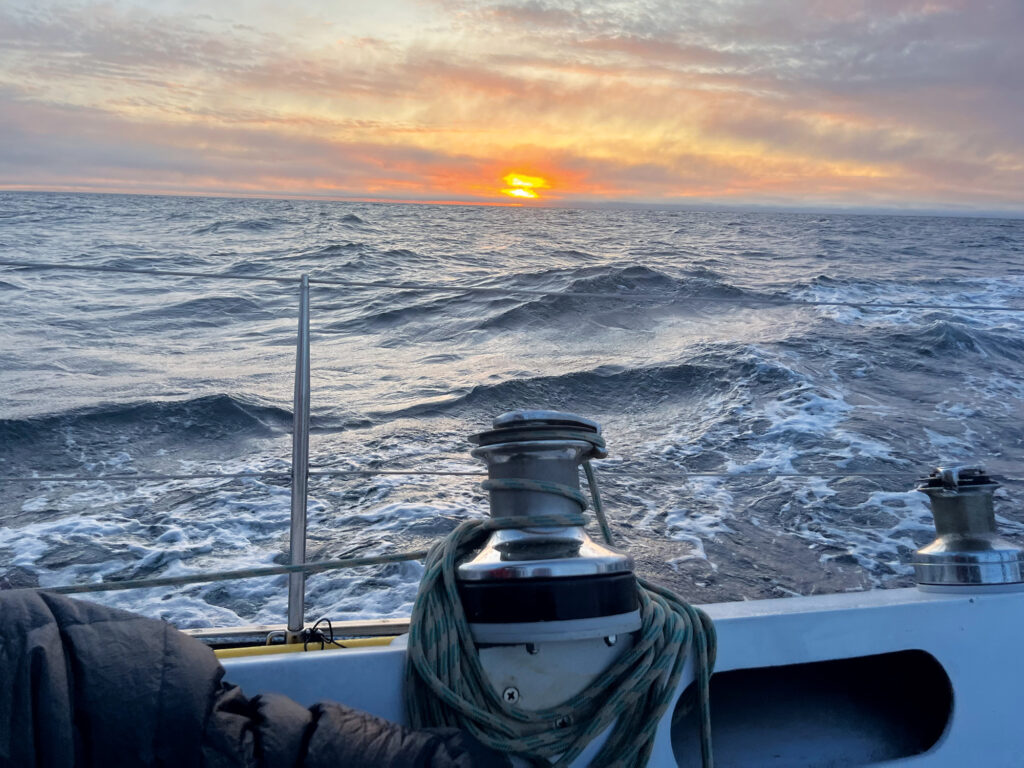
Before long, the lazy start to the day would pivot to something a bit more hectic.
Campbell River is accessed by a narrow waterway at the start of the Inside Passage known as Discovery Passage—so named by Capt. George Vancouver, the British explorer, after his HMS Discovery. This passage is bordered on its east side by the notorious Cape Mudge, described thusly in our cruising guide: “known for rips and overfalls.” Great. As we approached, we were set hard a good 20 degrees by a smoking opposing current, our speed through the water a miserly 0.9 knots. We trickled toward the opposite shore, were revved back up to 4.5 knots, and then caught a countercurrent, where we rocketed back to 8 blissful knots as we crossed the stripe of 50N, which seemed like a happy portent.
After a long, sometimes stressful day, it was great not only to tie up at the excellent Discovery Harbour Marina, but also to pay a visit (despite Mark’s totally expected evil eye) to the nearby, equally terrific government-sanctioned cannabis dispensary. Cool temps besides, one can chill out in Canada in more ways than one.
Perhaps it was the gummy, but the story from the friendly barkeep at a waterfront Campbell River pub, a seasoned local seaman himself, regarding our trip’s next upcoming attraction had me riveted from the get-go. Something about a rocky obstruction called “The Ripper”—a former formidable hazard, apparently to all mariners, until it was blown to absolute smithereens.
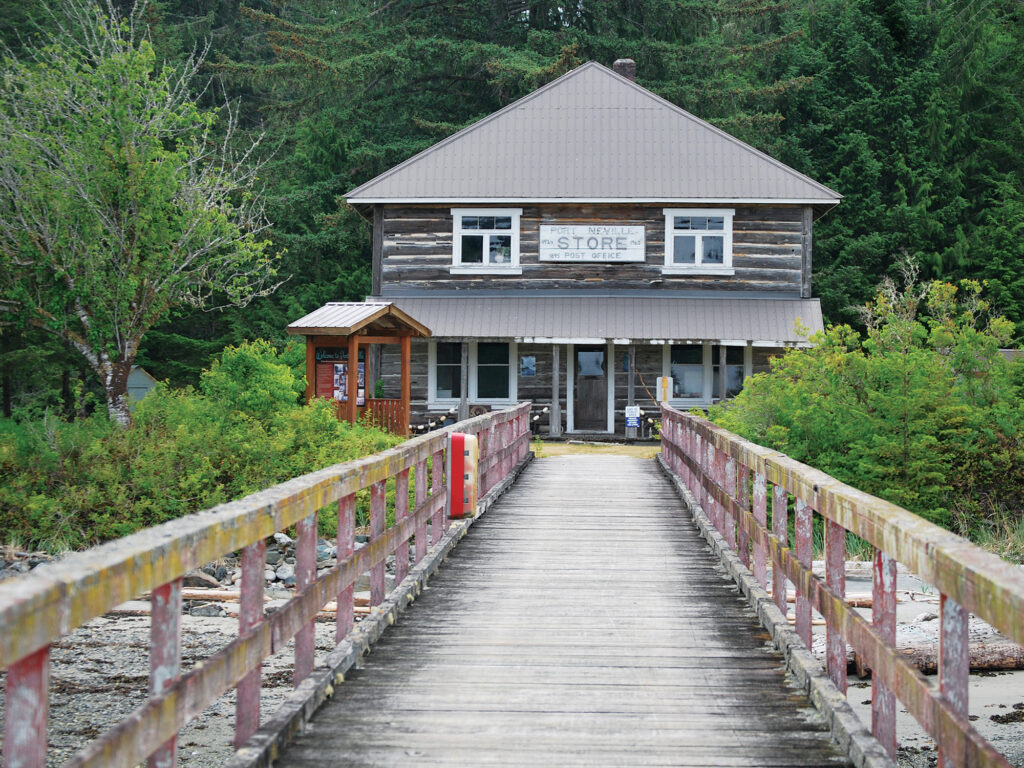
Ripple Rock—aka The Ripper—is a cornerstone of local lore, a seamount deposited smack dab in the middle of Seymour Narrows, a messy piece of swirling water in the best of conditions. More than a hundred vessels, and an almost equal number of unfortunate souls, fell prey to Ripple Rock before a demolition team flattened it in 1958 in what still counts as one of the largest non-nuclear explosions on record.
With a few butterflies in our stomachs, we were back underway the next morning. By now, we’d already been exposed to some pretty interesting currents, but we were still astonished at the Tilt-A-Whirl carnival ride through Seymour Narrows. Thankfully, we hit the north-flowing ebb on time, but once we were into the upwelling narrows, grasped by huge sucking holes of water, there wasn’t much to do except hang on and hope for the best. As usual, Dancing Bear handled it all with aplomb.
Johnstone Strait lay ahead, with a terrifying warning from the cruising guide that the prevailing staunch westerlies funneling down-channel could make for an extremely unsettling passage. But our luck was holding; a rare easterly filled in, and we enjoyed our best sailing so far—a certified downwind romp. The big bowls of snow atop the Vancouver Island peaks, with one spectacular waterfall spilling from the heights, totally enhanced the experience.
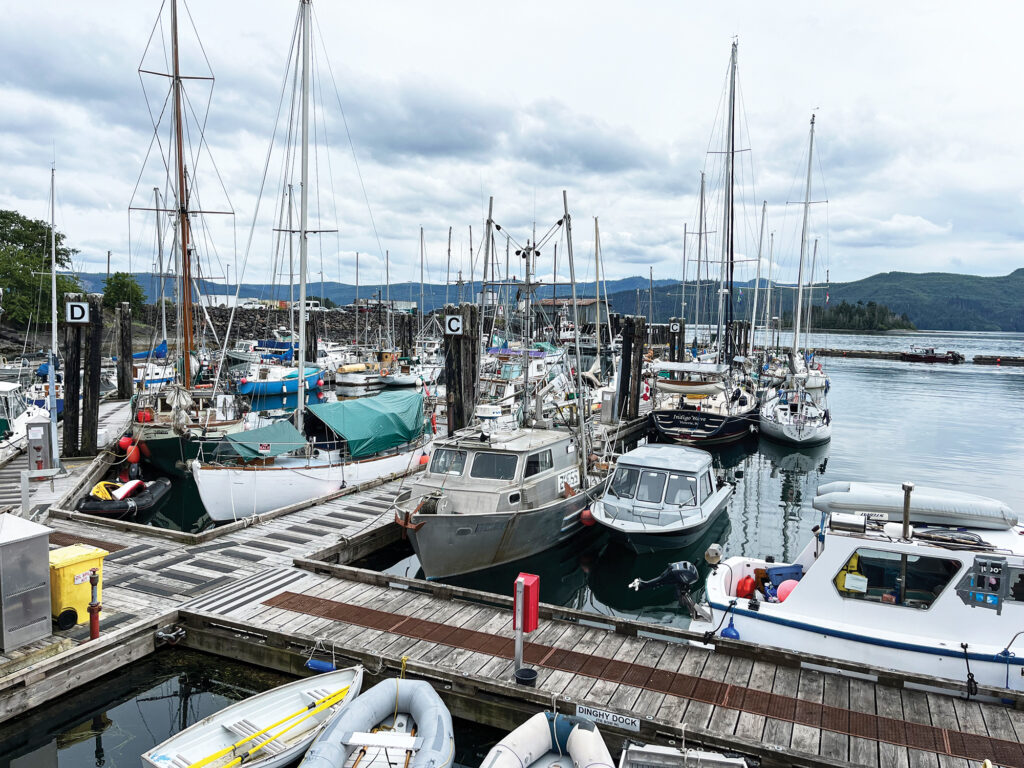
We made a sharp right past Ransom Point and tied up at the public dock at Port Neville, at the head of which stood a quiet post office and a welcome sign from the extended Hansen family, who have spent more than a century on this quiet backwater and apparently still call it home.
IV: On the Alert
Morning arrived with a slate-gray sky and a falling thermometer, the first we’d encountered. It provided a helpful reminder that we were still in the Pacific Northwest. We covered the 20-odd miles to Alert Bay in no time flat, and pulled into the little village just in time for the Indigenous Day celebrations. For Mark and me, this was a special place because it was one of the first and most memorable stops during our Around the Americas tour.
Alert Bay was where we got our initial exposure to the First Nations peoples, the native aboriginal culture who populated this coastline for more than 8,000 years. While now diminished in scope and numbers, they remain true and strong. We paid another visit to the town’s cultural center and were reacquainted with the world of totems and potlatches, as well as the region’s arts and artifacts. When exploring this coastline, it’s imperative to respect the spirits and symbols woven through the woods and waters. To do otherwise is to entirely miss the point.
On our way to Port Hardy, another 20 miles down the track, a pair of sea lions bid us adieu. As we skirted under Malcolm Island, in rapid succession we saw a whale, a family of sea otters, and a school of porpoises. It was like a bloody aquarium, and a sure sign of many good things to come.
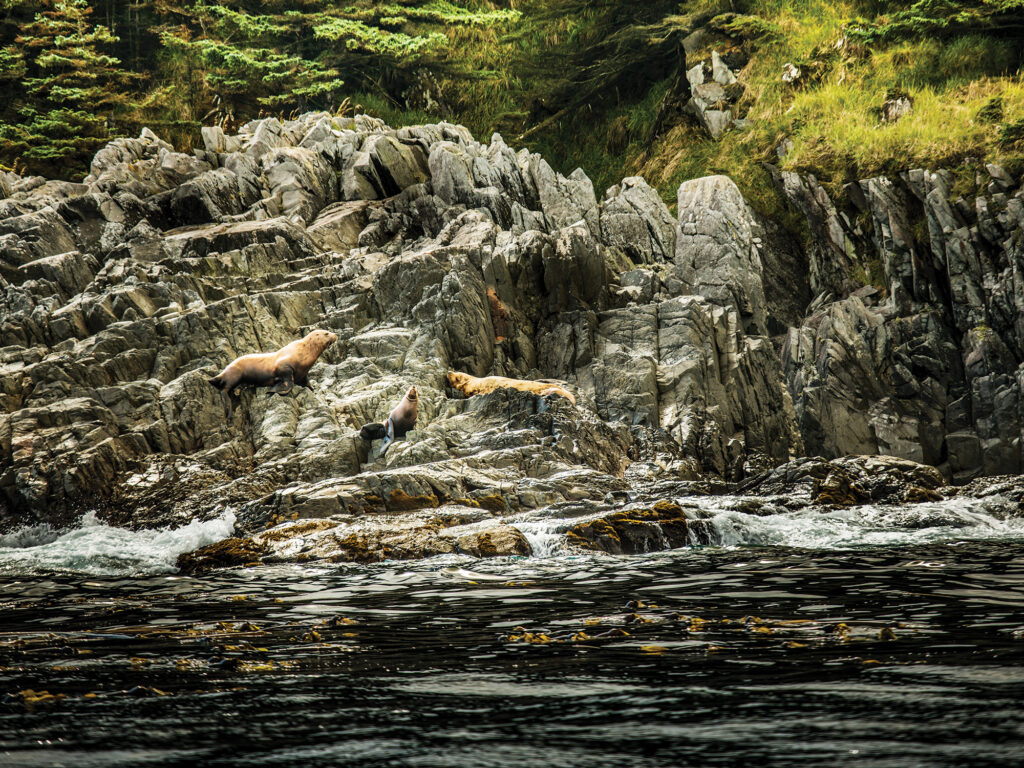
We pulled into the little harbor at the Quarterdeck Marina, and we exchanged waves with a local fisherman who, totally on cue as he cleaned his catch, blared the recently departed and nationally revered Gordon Lightfoot’s “The Wreck of the Edmund Fitzgerald,” which in every way imaginable seemed totally appropriate.
We were a week into the voyage, with a couple hundred winding miles behind us and another roughly 140 miles of open water yet to tackle to reach Haida Gwaii. There was certainly no turning back now.
The radar was on as we poked our way into the fog and out past the islands in Gordon Channel, the sea and sky a seamless amalgamation of gray. But the broader forecast was excellent, with high pressure settling over Haida Gwaii. And when a humpback whale breached behind as we approached Queen Charlotte Sound, it seemed like a fine omen.
The wind veered west at sunset, and we had a couple of hours of terrific sailing on a close reach, knocking off a fairly solid 8 knots. But we were headed by light northerlies after midnight, and it was a long, cold night. Sunrise, such as it was, occurred around 0530, when we also got our first glance at Moresby Island, the southernmost of the group, some 40 miles ahead.
We peeled off the layers of fleece and foulies as the sun ascended and we closed in, completely alone except for a single triangle of a distant sail against a long backdrop of low-slung green mountains and trees. It would be the last boat we’d see for many days. A trio of humpbacks appeared, and the pungent smell of sea lions wafted down on us from a rocky ledge covered with them.
We motored into a fjord called Carpenter Bay and anchored in 35 feet of water at its head, behind a small patch of rock and trees called Crowell Island. There wasn’t a soul within miles and miles. It felt spiritual. What came to mind was the title of my favorite song by the late, great Warren Zevon: “Splendid Isolation.”
V: Into the Mystic
Aboard Dancing Bear, Mark had fashioned a pair of nifty wooden slats that covered the cockpit well. When topped by the cushions, these slats turned the space into a quite comfortable bed. I’d slept under the stars every night of the trip. But waking up in Carpenter Bay, its shoreline shrouded in mist, was altogether different. The sheer beauty was one thing, but it was the absolute stillness, the all-encompassing quiet, that was mesmerizing. I’m not a particularly religious chap, but in this sacred place, surrounded by this pure nature, I felt graced by a higher power.
The silence was broken by an echoing thwap, thwap, thwap that sounded somewhat like the report of distant gunfire, which was impossible. We were anchored in the protected confines of the Gwaii Haanas National Park Reserve and Haida Heritage Site, where hunting and fishing were prohibited. Later that day, on a stroll on nearby Cowell Island, we solved the mystery: There in the distance, a humpback breached the surface and thwapped its tail hard, then did it again and again. It felt like being welcomed to the neighborhood.
But the best part? We were completely disconnected: no cellphone service, internet, news or social media. No indicted politicians, debt-ceiling woes or missing submersibles. Nothing. Just the magnificence.
Haida Gwaii’s literal translation is “islands of the Haida people.” It consists mainly of two large islands: Graham to the north and Moresby to the south, peppered with hundreds of small surrounding isles, a place where you could spend a lifetime exploring and never see it all. The Haida Nation has existed for 13,000 years, but from the late 1700s until 2010, Haida Gwaii was known as the Queen Charlotte Islands, before a reconciliation act returned the archipelago to its rightful handle. It also has a great nickname, “the Galapagos of the North,” which is pretty darn fitting.
Jenn said that we should have a theme song for the adventure. She had a pretty good playlist on her smartphone, and as the smell of fried eggs and sizzling bacon wafted up from below, on came the lyrics to a familiar Van Morrison tune: “Let your soul and spirits fly into the mystic.” Bingo. The song seemed to have chosen us.
Mark made the smart call early to spend the day in Carpenter Bay. Why leave perfection? The weather was sensational. We combed the coast and dived into the sea, and we spied the eagle in the big nest on Crowell as it soared and returned to keep a watchful eye on us, a sentinel, yet another neighbor we were grateful to know.
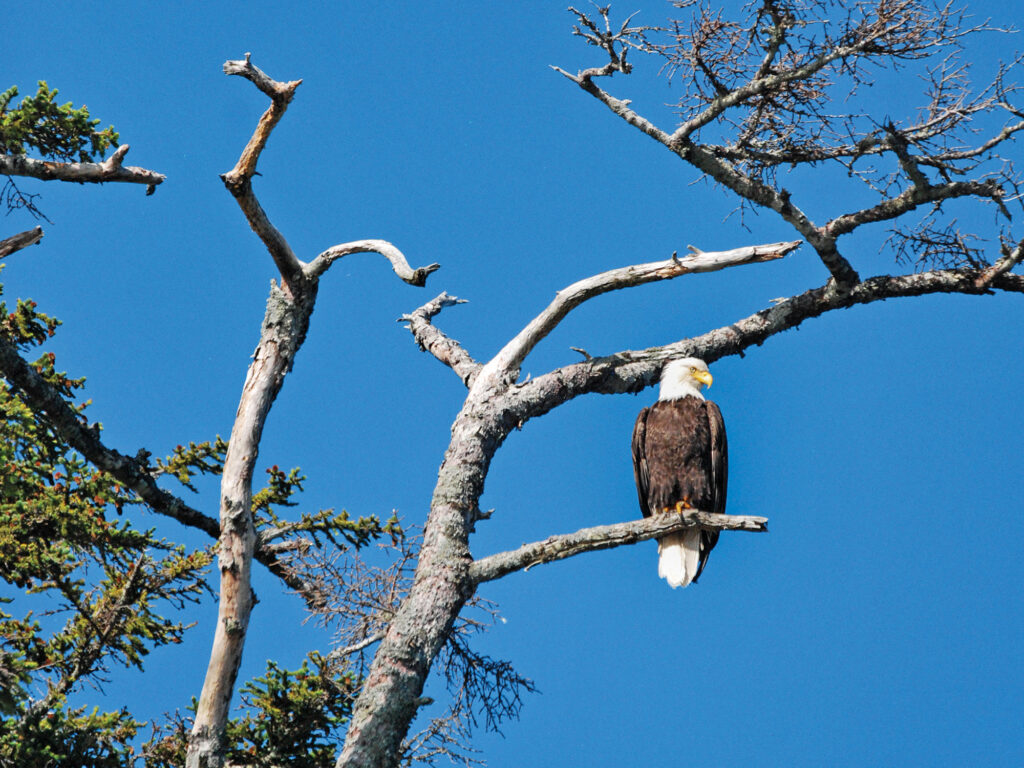
In the ensuing days, as we meandered north, each stop seemed to come with its own welcoming committee. Anchored behind Harriet Island off the abandoned settlement of Jedway, a mama bear and two cubs foraged along the shore. On Hutton Island, as a big westerly whistled down the inlet and a low cloud poured over the hills, a posse of sea otters played alongside while a family of elk grazed in the marsh. In Thurston Harbour on Talunkwan Island, Sitka deer snoozed along the shoreline, and the moving black dots turned out to be raccoons. When we got underway the next morning, the lagoon was pulsing with giant jellyfish, hundreds of them. We could’ve skipped ashore upon them.
We were all enhanced and entranced by the denizens of Haida Gwaii.
VI: Queen of a City
As all great voyages do, ours came to the end of the road. It was in the funky little village of Daajing Giids, formerly known as Queen Charlotte City. Despite a population hovering around 1,000 people, it felt like Manhattan after a week in true wilderness. Over the years, I’ve wrapped up many a trip in many an exotic location, but I’m not sure any were as fetching as Daajing Giids.
A cool dude named Max, boiling crab on the dock, hopped off his little sailboat to take our lines. A huge roar rose up, and up the hill, a raucous crowd attending a Little League baseball game had much to cheer about. Out in the harbor, a half-dozen cruising boats lay at anchor, including a trio of salty metal yachts and a ketch-rigged Amel Super Maramu. For heaven’s sake, there was an actual tidal grid for bottom jobs erected on the shoreline, and I couldn’t remember the last time I’d seen one of those. The black cod and salmon fillets at the pub around the corner were maybe the tastiest ever.
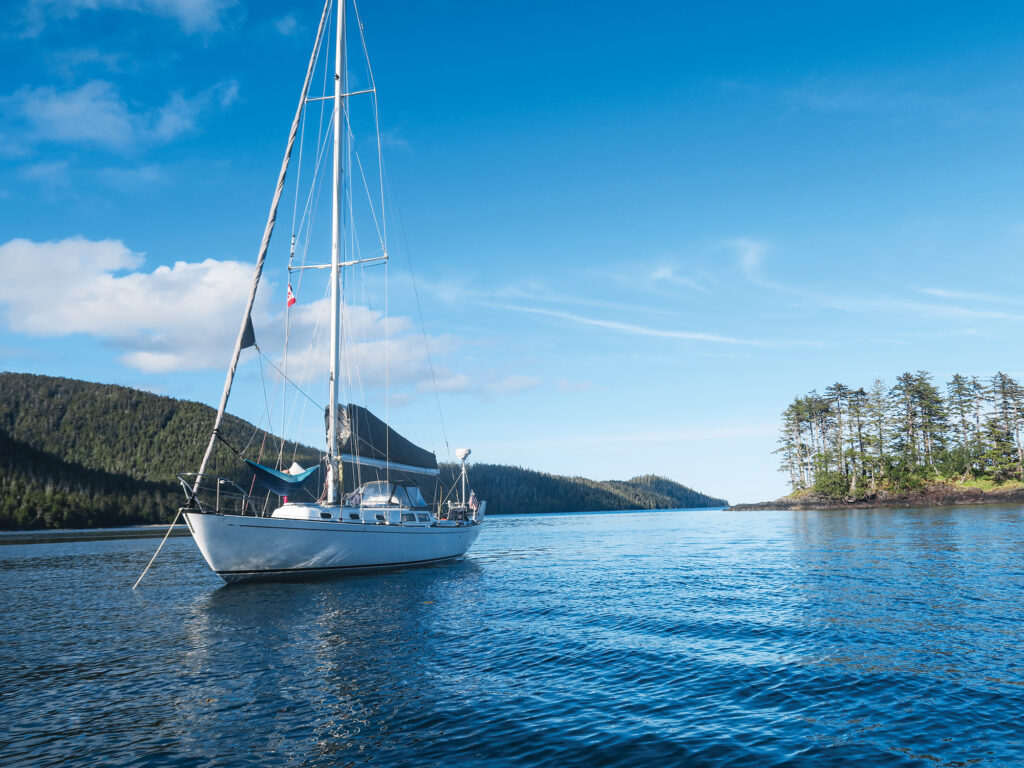
The next day, with exactly two weeks and 500 miles behind us since leaving Anacortes, I hopped a BC Ferry across the channel to the tiny regional airport at Skidegate for an hourlong flight to Vancouver and onward, back to the Real World. Leaving my mates on Dancing Bear to continue the adventure was bittersweet, to be sure, but I had a little piece of Haida Gwaii with me, an abalone shell I’d pocketed back in Carpenter Bay. And I sure as hell had left a slice of my soul behind.
It had been something more than a splendid, unforgettable journey. It was mystical.
Herb McCormick is a CW editor-at-large.








